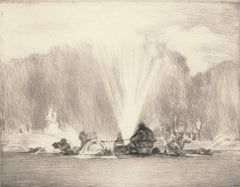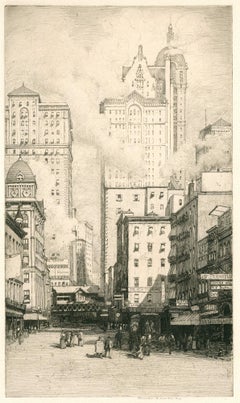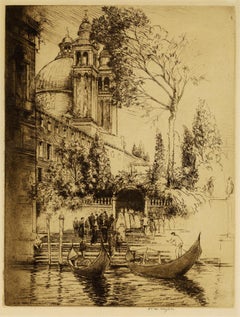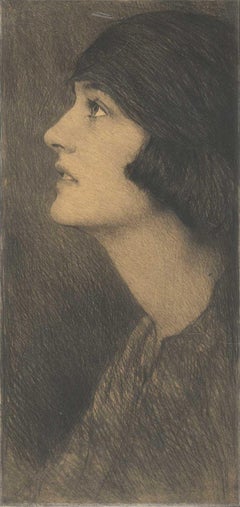Mortimer Menpes Figurative Prints
Australian, 1855-1938
Mortimer Luddington Menpes was born in Port Adelaide, South Australia on February 22, 1855, the second son of property developer James Menpes, who with his wife, Ann, had settled in Australia in 1839.Educated at Adelaide Educational Institution, he attended classes at the Adelaide School of Design, and did some excellent work as a photo-colourist, but his formal art training began at the School of Art in London in 1878, after his family had moved back to England in 1875. Edward Poynter was a fellow student at the school. Menpes first exhibited at the Royal Academy in 1880, and, over the following 20 years, 35 of his paintings and etchings were shown at the Academy.
Menpes set off on a sketching tour of Brittany in 1880, during which he met James McNeill Whistler. He became Whistler's pupil, and at one stage shared a flat with him at Cheyne Walk on the Chelsea Embankment in London. He was taught etching by Whistler, whose influence, together with that of Japanese design, is evident in his later work. Menpes became a major figure in the etching revival , producing more than seven hundred different etchings and drypoints , which he usually printed himself. As early as 1880, a selection of ten of his drypoint portraits, donated to the British Museum by Charles A. Howell, brought him critical acclaim.
In 1875, Menpes married fellow Australian Rosa Mary Grosse (d. 23 Aug 1936) in London. They had a son, Mortimer James (b. 1879) and two daughters, Rose Maud Goodwin and Dorothy Whistler.
A visit to Japan in 1887 led to his first one-man exhibition at Dowdeswell's Gallery in London. Menpes moved into a property at 25 Cadogan Gardens, Sloane Square, designed for him by A. H. Mackmurdo in 1888 and decorated it in the Japanese style. Whistler and Menpes quarreled in 1888 over the interior design of the house, which Whistler felt was a brazen copying of his own ideas. The house was sold in 1900, and Menpes moved to Kent.
In 1900, after the outbreak of the Boer War, Menpes was sent to South Africa as a war artist for the weekly illustrated magazine Black and White. After the end of the war in 1902, he travelled widely, visiting Burma, Egypt, France, India, Italy, Japan, Kashmir, Mexico, Morocco, and Spain. Many of his illustrations were published in travel books by A & C Black. His book on the Delhi Durbar was an illustrated record of the commemoration in Delhi of the coronation of King Edward VII.
Menpes became a member of the Royal Society of Painter-Etchers and Engravers (RE) in 1881, Royal Society of British Artists (RBA) in 1885, Royal Institute of Painters in Water Colours (RI) in 1897, and Royal Institute of Oil Painters (ROI) in 1899. In 1904 he published the memoir of his time with Whistler, Whistler as I Knew Him. Mortimer Menpes died in Pangebourne on April 1, 1938.to
1
1
Overall Width
to
Overall Height
to
1
3
859
382
376
308
1
1
1
1
1
1
1
1
1
1
1
1
Artist: Mortimer Menpes
Bassin d'Apollon, Versailles (Fountain of Appollo, Versailles).
By Mortimer Menpes
Located in Storrs, CT
Bassin d'Apollon, Versailles (Fountain of Appollo, Versailles). Drypoint. Menpes 364. 7 1/8 x 9 1/8 (sheet 8 13/16 x 10 7/8). A very rich impression with drypoint burr and plate tone...
Category
Early 20th Century Modern Mortimer Menpes Figurative Prints
Materials
Drypoint, Etching
$400 Sale Price
20% Off
Related Items
Cortland Street
Located in Middletown, NY
Etching with drypoint on antique handmade laid Japon paper, 12 7/8 x 7 1/2 (327 x 191 mm); sheet 15 5/16 x 10 7/16 (389 x 265 mm), full margins. Signed in pencil in the lower margin....
Category
Early 20th Century American Modern Mortimer Menpes Figurative Prints
Materials
Etching, Drypoint
Steps to the Grand Canal, St. Mark's in the distance, Venice.
By Donald Shaw MacLaughlan
Located in Middletown, NY
A lovely view of Venice from the water.
Etching with drypoint on antique cream laid paper with a large figural watermark, signed in pencil, lower right. 14 1/4 x 11 inches (362 x 280...
Category
Early 20th Century American Modern Mortimer Menpes Figurative Prints
Materials
Laid Paper, Drypoint, Etching
Chicago Skyline
By Paul Schumann
Located in Middletown, NY
A beautiful turn-of-the-century lake view of Chicago by an American artist known for his Texas landscapes.
Etching with drypoint on watermarked Umbria laid paper with deckle edges, 7 1/4 x 10 7/8 inches (182 x 275 mm), full margins. Signed and numbered 4/25 in pencil, lower margin. In good condition with adhesive residue at the sheet edges on the verso, does not show through to the recto. A lovely Lake Michigan landscape...
Category
Early 20th Century American Modern Mortimer Menpes Figurative Prints
Materials
Handmade Paper, Etching, Drypoint
Low Country (South Carolina)
By Elizabeth Verner
Located in Middletown, NY
An enchanting Southern landscape by the mother of the Charleston Renaissance.
A native of Charleston, South Carolina, and educated under the tutelage of Thomas Anshutz at The Pennsylvania Academy of Fine Arts, O'Neill Verner was a teacher, a mother, an artist, an ardent preservationist, and a skilled autodidact. Having previously focused on painting, in the early 1920s she found herself deeply moved by printmaking as a media, and especially so by the simple, peaceful themes and tableaus she discovered in Japanese art. She embarked on a effort to teach herself Japanese printmaking techniques, and in the process, produced the charming images of every day life in Charleston and its environs that earned her recognition as a cultural icon in her day, and in more modern times, as the mother of the Charleston Renaissance, which flourished well into the 1930s. In 1923 she opened a studio in Charleston where she focused on documenting the local color and the architecture and landscape that distinguishes Charleston as one of the South's most beautiful cities, all the while applying the gentle and poetic thematic sensibilities of Japanese printmaking. O'Neill Verner soon found herself in high demand when municipalities and institutions throughout the country sought commissions from her to document the beauty of their grounds and historic buildings. She worked as far north as the campuses of Harvard and Princeton, and extensively across the South, including in Savannah, Georgia, where through sweeping commissions she was able to marry her love of southern preservation and art. O'Neill Verner was a lifelong learner, and continued a path of edification that led her to study etching at the Central School of Art in London, to travel extensively through Europe, and to visit Japan in 1937, where she studied sumi (brush and ink) painting. She was a founding member of the Charleston Etchers Club, and the Southern States Art League. Her works are represented in the permanent collections of leading museums across the American south, and in major national institutions including the Metropolitan Museum of Art, Boston's Museum of Fine Art, and the Smithsonian American Art Museum. O'Neil Verner...
Category
Early 20th Century American Modern Mortimer Menpes Figurative Prints
Materials
Archival Paper, Drypoint, Etching
Tugs on the Hudson
By Charles Frederick William Mielatz
Located in Middletown, NY
Drypoint etching with engraving printed in black ink on Japanese mulberry paper, 4 1/2 x 3 3/8 inches (113 x 84 mm), full margins. In superb condition. A beautiful New York City river...
Category
Early 20th Century American Modern Mortimer Menpes Figurative Prints
Materials
Handmade Paper, Drypoint, Etching
New York Skyline
By Louis H. Ruyl
Located in Middletown, NY
Etching with drypoint on cream wove paper with deckle edges, 4 3/8 x 12 3/4 inches (233 x 323 mm); sheet 9 1/2 x 15 3/4 inches (240 x 338 mm), full margins. Signed and numbered 4/75 ...
Category
Early 20th Century American Modern Mortimer Menpes Figurative Prints
Materials
Handmade Paper, Etching, Drypoint
Cherry Street
By Charles Frederick William Mielatz
Located in Middletown, NY
A view of lower Manhattan's Cherry Street as it appeared at the turn of the 20th century. One of only 5 proof impressions.
New York: 1904.
Drypoint with aquatint on watermarked, cr...
Category
Early 20th Century American Modern Mortimer Menpes Figurative Prints
Materials
Handmade Paper, Drypoint, Etching
Fonte Nuova, Siena
By Joseph Pennell
Located in Middletown, NY
Etching with drypoint on lightweight Japon paper, 9 3/4 x 9 7/8 inches ( 247 x 250 mm); sheet 14 x 12 3/4 inches (355 x 324 mm), full margins. Signed in pencil in the lower margin. I...
Category
Late 19th Century American Modern Mortimer Menpes Figurative Prints
Materials
Handmade Paper, Drypoint, Etching
Ponte della Trinità, Florence
By David Young Cameron
Located in Middletown, NY
Etching and drypoint on tissue-thin cream laid paper, 6 5/8 x 8 1/8 inches (167 x 205 mm), full margins. Signed in pencil in the lower right margin, and inscribed "Ponte Trinità, Florence" in pencil the lower left margin. Non-archival paper tape tabs at the top right and left corners on the verso, with minor associated discoloration which presents on the recto. Minor, light mat tone, and some very small losses at the extreme corners, well outside of image area. The numerals "325" written in pencil in the lower right margin, in reference to the Rinder catalog number. A beautiful, silvery, early-state impression.
Rinder 325
[Rinder 325 iii/vii].
The son of a clergyman, Sir David Young Cameron was born in Glasgow in 1865. After a brief and unhappy dalliance in the fields of business and law, Cameron began attending the prestigious Glasgow School of the Arts in 1881, and later the Edinburgh School of the Arts. At first associated with the Glasgow Boys (John Lavery, Joseph Crawhall...
Category
Early 20th Century Modern Mortimer Menpes Figurative Prints
Materials
Laid Paper, Drypoint, Etching
Ludgate Hill
By William Walcot R. E. Hon. R. I. B. A.
Located in Middletown, NY
Etching with drypoint and aquatint on light cream wove paper, 5 1/2 x 5 inches (140 x 122 mm), full margins. Signed in pencil in the lower margin. One of a total of 400 signed impres...
Category
Early 20th Century Modern Mortimer Menpes Figurative Prints
Materials
Etching, Aquatint, Drypoint
Street in Marblehead, Massachussets
By Lawrence Wilbur
Located in Middletown, NY
Drypoint etching on white, buff laid paper with deckle edges, 8 13/16 x 12 inches (224 x 305 mm), full margins. One of only 25 proof impressions. In superb condition with excellent i...
Category
1930s American Modern Mortimer Menpes Figurative Prints
Materials
Archival Paper, Drypoint, Etching
Market Square, Rothenburg, Germany
Located in Middletown, NY
Etching and drypoint on cream wove paper, 10 3/4 x 7 1/2 inches (270 x 190 mm), full margins. Signed, inscribed and titled in pencil, lower margin. In good condition with minor mat t...
Category
Early 20th Century Modern Mortimer Menpes Figurative Prints
Materials
Handmade Paper, Drypoint, Etching
Previously Available Items
Portrait of Mrs. Monkton Hill
By Mortimer Menpes
Located in New Orleans, LA
A beautiful haunting portrait of Mrs Monkton Hill
Born in Adelaide, South Australia, Mortimer Menpes came to England in 1875. By the time of his momentous meeting with Whistler in 1...
Category
Late 19th Century English School Mortimer Menpes Figurative Prints
Materials
Drypoint
Portrait of Whistler with the White Lock, Wearing a Monocle.
By Mortimer Menpes
Located in Storrs, CT
Mortimer Luddington Menpes, N.E.A.C., R.B.A., R.E., R.I., R.O.I.
c. 1880. Drypoint. Menpes 22. 6 1/2 x 5 3/4 (sheet 11 x 8 7/8). A fine impression printed on '[ing]res FRANCE' coun...
Category
Late 19th Century Impressionist Mortimer Menpes Figurative Prints
Materials
Drypoint
H 20 in W 16 in D 2 in
Mortimer Menpes figurative prints for sale on 1stDibs.
Find a wide variety of authentic Mortimer Menpes figurative prints available for sale on 1stDibs. Not every interior allows for large Mortimer Menpes figurative prints, so small editions measuring 10 inches across are available. Customers who are interested in this artist might also find the work of Donald Shaw MacLaughlan, William Walcot, R.E., Hon.R.I.B.A., and Georges-Henri Tribout. Mortimer Menpes figurative prints prices can differ depending upon medium, time period and other attributes. On 1stDibs, the price for these items starts at $400 and tops out at $400, while the average work can sell for $400.



